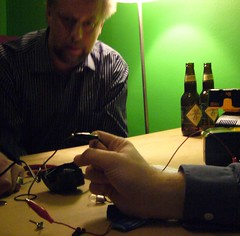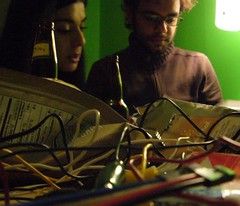Our first hacknight (last night) was… a blast. Due to confusion we had to change the venue at the last minute to — my home office. There have never been so many people (me, Edward, Patrick, Ana-Maria, Dave, Liam, Michael and Susan) in the room at once.
We’re building a wifi backpack, which we’ve affectionately called the WiFi Roach Coach (long story). It’ll be a battery-powered WRT54GL and Rogers/Bell/Inukshuk pre-WiMax modem providing connectivity. (It’s a NextNet Expedience RSU-2510-AV.) This’ll allow us to set up an instant Wireless Toronto hotspot anyplace where we can get a (pre-)WiMax signal. It’ll be especially useful to provide wifi coverage at events.
 We started off well: we got a modem, router, two 18V Ryobi (cordless drill) batteries, a battery charger, and a 18V battery flashlight — from which we’d remove the light and plug into the two boxes. Patrick bought a nice blue backpack.
We started off well: we got a modem, router, two 18V Ryobi (cordless drill) batteries, a battery charger, and a 18V battery flashlight — from which we’d remove the light and plug into the two boxes. Patrick bought a nice blue backpack.
While the WRT54GL comes with a 12VDC, 1A power supply, I’d read that it can run on a wide range of voltages. Patrick unscrewed the flashlight, Dave hooked up the leads, Michael stripped the power supply cable, and we plugged it all in: success. The lights on the router came on and looked normal. w00t.
Next, we tried the modem. Same setup, different power cable. The modem has a 13VDC, 1.3A power supply — pretty close. In our giddiness and haste, we made the poor assumption that the modem would be similarly forgiving about the higher voltage.
We plugged it in, Dave hit the switch on the flashlight, and nothing happened. We sat. About 5 seconds later, there were a series of really loud pops — at least three, maybe as many at seven. A horrible smell filled the room, while a huge plume of smoke rose to the ceiling.
Oops.
 So, we passed around another round of beers, and lamented. Ana-Maria — the only engineer among us — drew what we *should* have done… figured out the impedance of the router and modem, and added in the appropriate resistors to bring the voltage down to 13V. (Or this is what I think she said, anyway.)
So, we passed around another round of beers, and lamented. Ana-Maria — the only engineer among us — drew what we *should* have done… figured out the impedance of the router and modem, and added in the appropriate resistors to bring the voltage down to 13V. (Or this is what I think she said, anyway.)
We then (seven of us!) trekked back to the store where I bought the modem, hoping for a quick and painless exchange. Sadly, they were closed — we’ll have to try again another time. We bought potato chips (organic!) and walked back. We ate chips, made fun of ourselves, and cleaned up. Venceremos!
Thanks to Edward, Patrick and me for the beer, with special thanks to Patrick for carrying it all. (And sorry I forgot to tell you that the alleyway jogs at Markham.)
More photos from Dave are, hopefully, forthcoming.
Future hacknights will be held at InterAccess… sorry for the confusion this time. The next one will be sometime next month, though there may be a mini-hacknight soon, to finish the roach coach. Details on the discuss list.

 We started off well: we got a modem, router, two 18V Ryobi (cordless drill) batteries, a battery charger, and a 18V battery flashlight — from which we’d remove the light and plug into the two boxes. Patrick bought a nice blue backpack.
We started off well: we got a modem, router, two 18V Ryobi (cordless drill) batteries, a battery charger, and a 18V battery flashlight — from which we’d remove the light and plug into the two boxes. Patrick bought a nice blue backpack. So, we passed around another round of beers, and lamented. Ana-Maria — the only engineer among us — drew what we *should* have done… figured out the impedance of the router and modem, and added in the appropriate resistors to bring the voltage down to 13V. (Or this is what I think she said, anyway.)
So, we passed around another round of beers, and lamented. Ana-Maria — the only engineer among us — drew what we *should* have done… figured out the impedance of the router and modem, and added in the appropriate resistors to bring the voltage down to 13V. (Or this is what I think she said, anyway.) We’re happy to launch the first Wireless Toronto venue on the east side! The Renaissance Cafe serves coffee, food and is licensed, and hosts many spoken word and music events. 1938 Danforth Ave, one block west of Woodbine.
We’re happy to launch the first Wireless Toronto venue on the east side! The Renaissance Cafe serves coffee, food and is licensed, and hosts many spoken word and music events. 1938 Danforth Ave, one block west of Woodbine. 
